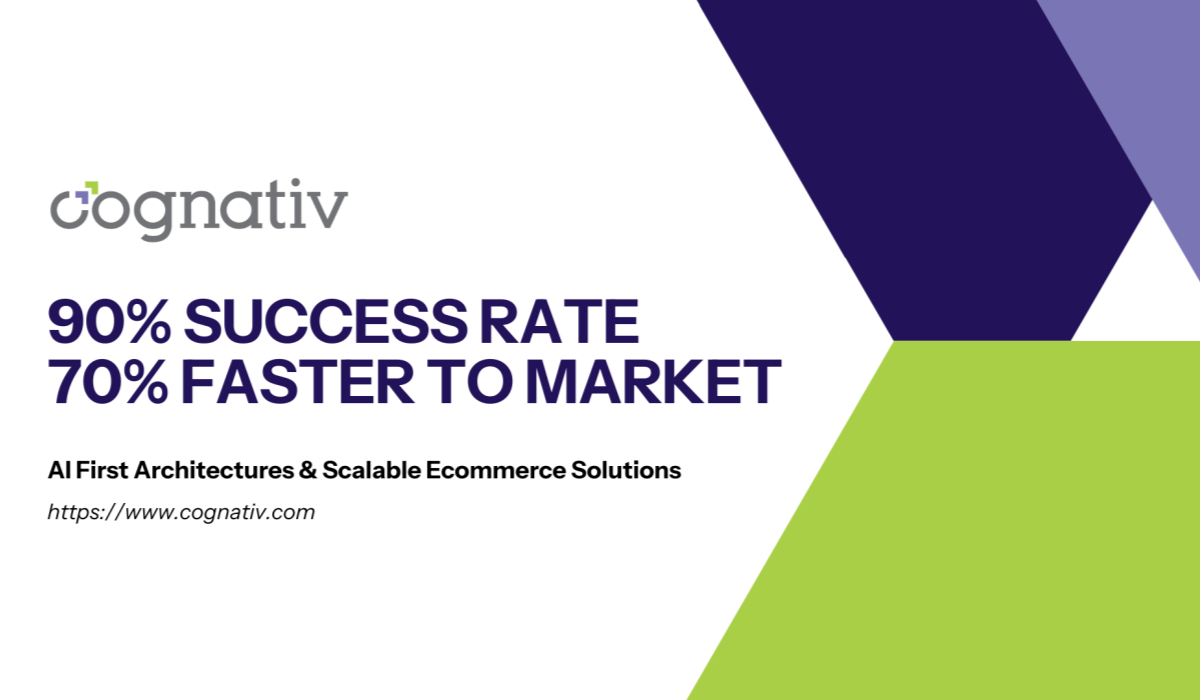Price of Software Development: Essential Guide for Project Costs
If you’re looking to develop software, one of your first questions will likely be: how much will it cost? The price of software development varies significantly based on factors like project complexity, the technology stack, and the team’s location. In 2025, you can expect to pay anywhere from $50,000 to well over $1,000,000, depending on your specific needs. This guide will break down these costs and the factors that influence them, helping you budget more effectively.
Key Takeaways
-
In 2025, software development costs range from $50,000 to over $1,000,000, influenced by project complexity, required features, and development team location.
-
Budgeting for software projects involves understanding cost breakdowns across various development stages, with the development stage accounting for approximately 63% of total costs.
-
Selecting the appropriate pricing model—fixed price, time-and-materials, or dedicated team—affects project costs and adaptability, necessitating careful consideration based on project requirements.
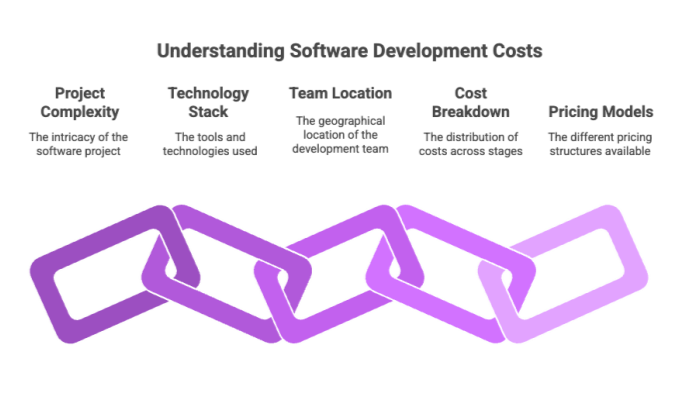

Understanding Software Development Costs
Software development costs are primarily driven by hourly software developers rates and the software costs and development time of the project. Entrepreneurs and business leaders rely on accurate cost estimation to make informed decisions and manage budgets effectively.
Estimates rely on a detailed understanding of the project’s scope and unique features, typically provided by the software development vendor. The costs vary based on specific features and requirements, much like building a house – the more complex the structure, the higher the cost.
Technological advancements and market demands are key factors that influence these costs.
Average software development cost in 2025
In 2025, the average software development price range for the cost of software development projects is between $50,000 and $250,000, depending on the project’s complexity and requirements. Examples include:
-
Developing a business platform: $40,000 to over $500,000
-
Small to midsized enterprises seeking medium complexity software solutions: around £56,000 to £80,000
-
Developing a Minimum Viable Product (MVP): £24,000 to £36,000, based on team location and project scope. Software development prices vary significantly based on these factors.
High-end software for large enterprises starts at around £80,000, with complex applications like UberEats reaching approximately $150,000. Additional costs for highly complex software projects can exceed $1,000,000, emphasizing the importance of thorough cost estimation and planning to avoid budget overruns.
These figures underscore the diverse costs of software development, emphasizing the need for businesses to align budgets with business objectives and project goals and requirements.
Cost breakdown by development stages
Accurately budgeting requires an understanding of the cost breakdown by development stages:
-
Planning phase: consumes a significant portion of the budget and is crucial for seamless integration and operation within existing systems.
-
Design phase: typically accounts for 15-25% of the total budget.
-
Development stage: the most resource-intensive, comprising approximately 63% of the total costs.
-
Quality Assurance (QA): accounts for about 15% of the budget.
-
Project Management: accounts for about 15% of the budget.
-
UI/UX design: takes up around 7% of the budget.
Quality assurance ensures the software is free from flaws, meets requirements, and is competitive, secure, and user-friendly. Testing budgets usually range from 10-20% of the total budget, highlighting the need to allocate sufficient resources for a successful software development project.

Major Factors Influencing Software Development Pricing
Several major factors influence software development pricing, including project complexity, technology stack and platform choice, and the expertise and location of the development team.
Understanding these factors can help businesses manage their business processes and software development costs more effectively.
Project complexity and requirements
A software project’s complexity directly impacts its cost:
-
Advanced features and higher functionality demand more development effort, leading to increased costs.
-
Projects are often categorized by complexity levels, with higher complexity resulting in longer development times and higher expenses.
-
For example, integrating sophisticated features like AI or geolocation can significantly raise the overall costs due to the additional time and resources required.
The complexity of the app’s user interface design plays a crucial role in determining costs. Factors that contribute to higher development costs include:
-
Custom artwork
-
Animations
-
Responsive design
-
Accessibility features
Initial total cost estimates can vary significantly based on multiple factors.
Thus, having a clear grasp of the project’s complexity and requirements is vital for effective budget management.
Technology stack and platform choice
The chosen technology stack and platform significantly impact the software development budget. Different technologies carry different costs, and modern tech stacks may require specialized expertise, impacting overall expenses. For example, choosing between native and cross-platform app development can influence the budget. While cross-platform development may seem cost-effective, it can have performance trade-offs compared to native app development.
Using frameworks like Flutter allows development on multiple platforms with a single codebase, making it a cost-effective solution for cross-platform development. Selecting the appropriate technology stack and platform is key to managing costs effectively and meeting performance requirements.
Team expertise and location
A development team’s expertise and location greatly influence software development costs. Senior developers command higher rates, which impacts the total costs of the project. For example:
-
The average annual salary of a software developer in Switzerland is over $100,000.
-
In Poland, the average annual salary is about $65,000.
-
The average hourly fee for developers in the US or Western Europe is $100 per hour.
-
In Central and Eastern Europe, the average hourly fee ranges from $50 to $70 per hour.
Location plays a crucial role in cost; regions with lower living costs generally have cheaper development rates. Knowing the costs associated with each role aids in accurately estimating the overall budget and making informed decisions about team composition and location.
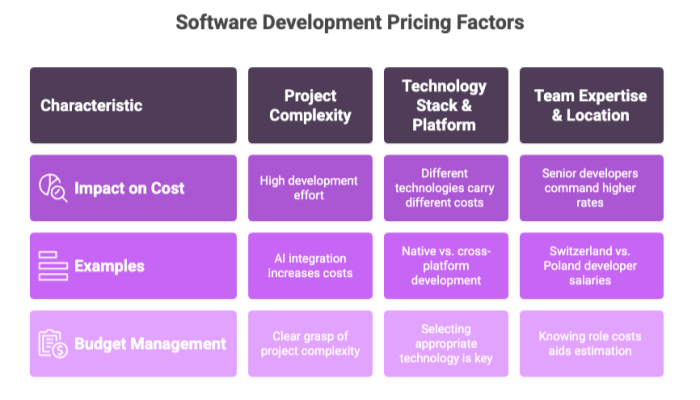

Different Pricing Models in Software Development
Different pricing models in software development have significant implications for project costs. The pricing model chosen can influence the overall budget and project flexibility.
There are several common models. These include the Fixed Price Model, Time-and-Materials Model, and Dedicated Team Model.
Fixed price model
The fixed price model:
-
Sets a predetermined sum for well-defined requirements, offering clarity before project initiation.
-
Is particularly suitable for projects with well-defined requirements that are unlikely to change during development.
-
Has the key advantage of predictability, offering clear costs for well-defined requirements.
-
Has downsides such as rigidity and limited adaptability to changes.
In fixed price contracts, project managers should focus on meeting scope within budget over innovation, ensuring costs remain stable regardless of time spent. This model is ideal for projects where the requirements are clear and unlikely to change, providing a cost-effective solution for well-defined projects.
Time-and-materials model
The time-and-materials model offers flexibility and allows adaptation to changing requirements. Clients in a time-and-materials arrangement can modify the project scope as it progresses. This model is suitable for projects where the requirements may evolve over time, allowing for budget reviews based on actual deliverables.
However, one of the disadvantages of the time-and-materials model is that total costs may end up being significantly higher than initially estimated. The model manages the development process by dividing it into smaller fixed-cost or fixed-time phases, providing flexibility and adaptability to changing project needs.
Dedicated team model
The dedicated team model is a structure where a team is solely dedicated to a project, billing monthly or as per contract. This model may incur higher overall costs due to the team’s exclusive commitment to the project. The development team’s expertise is crucial in costs, with more experienced teams charging higher rates but delivering better quality.
The size and geographical location of the development team can impact project costs; remote teams may benefit from lower living costs. Choosing a dedicated team model can provide consistent team involvement and focus, which is beneficial for long-term projects.
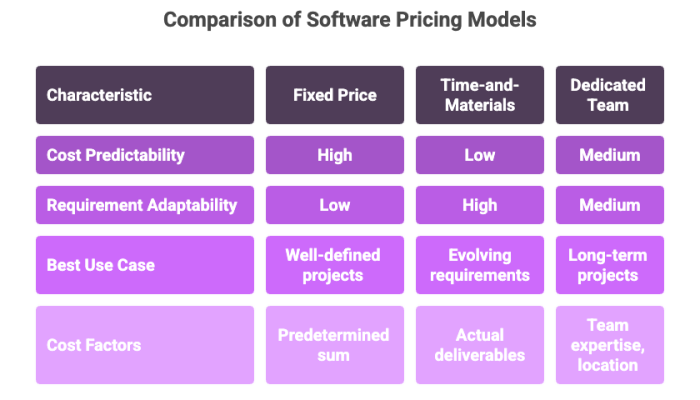

Cost Estimation Techniques for Software Development Projects
Estimating software development costs effectively involves understanding the type of software, project requirements, complexity level, timeline, and software development cost estimation.
Various techniques can be used to estimate costs, including rough and detailed estimation approaches.
Rough estimation techniques
Rough estimation techniques typically start with initial assessments followed by detailed analysis. Factors considered in the rough estimates include work scope, the complexity of the solution concept, and potential pitfalls. Some companies estimate software development costs based on either the duration of the project or the number of people needed.
In the Solution Design Stage, clients receive three estimate variations: optimistic, realistic, and pessimistic. The precision range of a rough estimate typically falls between 25% to 75%. These rough estimates offer a general idea of project costs, aiding businesses in budget planning.
Detailed estimation approaches
Detailed estimation techniques encompass:
-
Comprehensive scoping and analysis to determine accurate cost breakdown.
-
Accounting for specific requirements and potential risks associated with the project.
-
Breaking down projects into smaller, manageable tasks to allow for greater accuracy in cost estimation.
Launching a minimum viable product (MVP) can help focus resources on critical functionalities first, leading to better cost management. Focusing on core functionalities allows businesses to efficiently use resources and manage development costs.
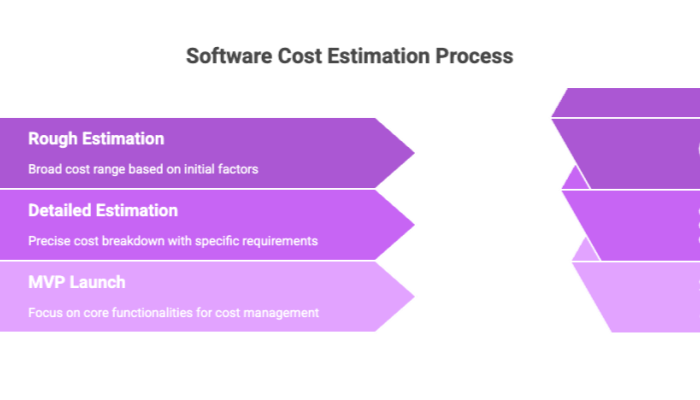

Strategies to Reduce Software Development Costs
Reducing software development costs requires practical strategies like embracing open-source solutions, optimizing project management practices, and significantly reducing development time while prioritizing essential features in the software development lifecycle, including developing software, software creation, and machine learning to save money.
Embrace open-source solutions
Open-source software reduces costs by:
-
Providing functionality without licensing fees.
-
Eliminating the need for costly licensing through the use of open-source components, lowering overall project expenses.
-
Using ready-made services instead of custom builds, which can further reduce development costs and allow projects to launch faster and more economically.
Embracing open-source solutions and integrating existing services can significantly enhance cost-efficiency in software development projects. This approach allows businesses to leverage existing technology, saving time and resources while maintaining high-quality standards.
Optimize project management practices
Agile methodologies offer flexibility and responsiveness, helping to prevent costly rework. Agile methodologies enhance adaptability and minimize unnecessary expenditures during development. Effective communication is critical for managing development costs and meeting project timelines.
Collaborating with the development team significantly influences project success and budget adherence. Effective collaboration boosts productivity by fostering a shared understanding and leveraging diverse expertise among team members. This collaborative approach ensures that the project stays on track and within budget.
Prioritize essential features
Focusing on developing core functionalities ensures that the product meets essential user needs from the start. Core features can help in acquiring initial customers and gaining feedback for further improvements. Planning for future enhancements allows teams to understand user requirements better over time.
With a clear roadmap for advanced features, mobile development can remain agile and responsive to user feedback. Adopting a phased development approach enables gradual integration of advanced features without overwhelming the system. This approach minimizes risks and allows for easier adjustments based on evolving user needs.
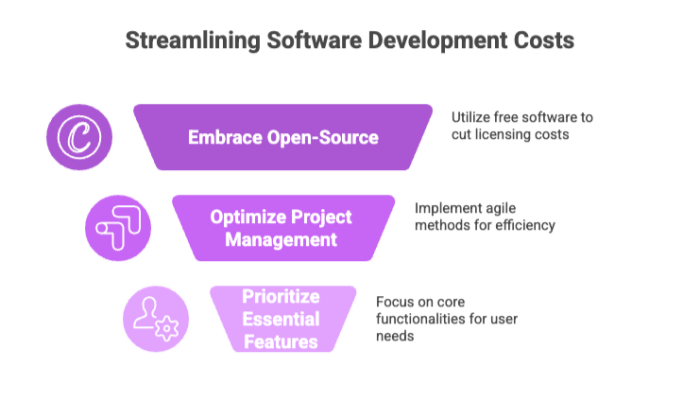

Additional Costs to Consider in Software Development
When planning a software development project, it’s crucial to consider additional costs that may arise beyond the initial development expenses. These costs can include infrastructure and hosting, maintenance and updates, and compliance and security measures.
Infrastructure and hosting costs
Ongoing costs for software infrastructure include hosting, server space, and database expenses. As the user base grows, infrastructure costs can increase due to the need for additional storage, bandwidth, processing power, and computing resources. Cloud services offer scalable infrastructure solutions, with costs varying based on usage.
Regular updates to the infrastructure may be necessary due to changes in user devices or operating systems, impacting maintenance costs and external systems. Businesses should budget for these ongoing maintenance expenses to ensure their software remains functional and efficient.
Maintenance and updates
Maintenance and updates are critical considerations beyond initial development. Post-launch, it’s essential to budget effectively for maintenance and support costs to keep the software running smoothly. Ongoing updates and enhancements contribute to higher long-term software development costs.
Organizations should incorporate maintenance and update costs into their overall software development budget to ensure they can continue to support and improve their software over time.
Compliance and security measures
Achieving compliance with industry regulations often requires specific certifications such as ISO 9001 and ISO 27001. The costs associated with obtaining these certifications can be significant, contributing to the overall budget for software development projects. Integrating security protocols into software can increase development costs due to the complexities involved in implementation.
Both compliance and security measures should be factored into the overall cost estimations for software development to ensure a comprehensive budget.
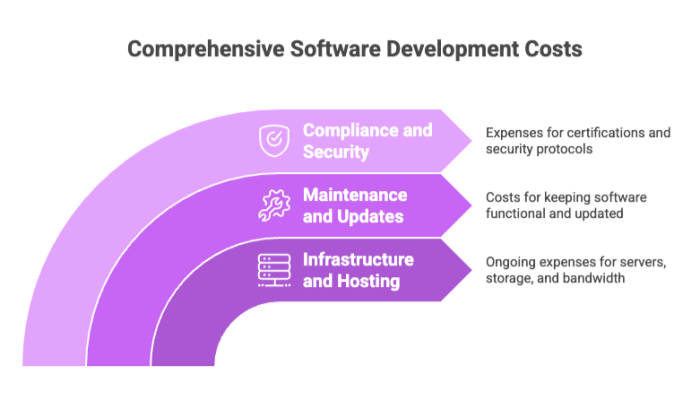

Selecting the Right Software Development Partner
Choosing the right custom software development partner is crucial for the success of your project. A suitable software development company can provide expertise, resources, and tailored solutions that influence bespoke software development pricing. To ensure the best outcomes, many software development companies choose to build custom software with a dedicated software development team.
This section will guide you through evaluating potential partners and emphasize the importance of communication and collaboration.
Evaluating experience and portfolio
A comprehensive portfolio review should include:
-
Examining the diversity of projects undertaken by the development firm.
-
Assessing the quality and user experience of the applications in a portfolio to gauge the firm’s competence.
-
Reviewing a partner’s past projects and client feedback to assess their capability and alignment with your goals.
By thoroughly evaluating a potential partner’s experience and portfolio, you can ensure they have the skills and expertise required for your project, increasing the likelihood of a successful collaboration.
Communication and collaboration
Clear communication among all stakeholders is essential for successful software development, minimizing misunderstandings. Effective communication ensures all requirements are understood, reducing the risk of costly revisions. Implementing collaborative practices such as regular check-ins and agile methodologies fosters better teamwork and improves project outcomes.
Ultimately, enhancing communication and collaboration can lead to more efficient project execution and reduced costs. A strong partnership with open communication channels ensures that the project stays on track and meets its objectives.
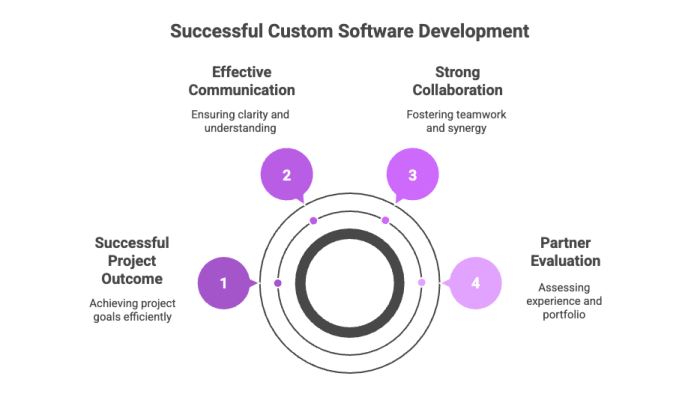

Summary
Navigating the intricacies of software development costs in 2025 requires a deep understanding of various factors, from project complexity and technology stack choices to the expertise and location of the development team. By exploring different pricing models, businesses can choose the one that best fits their project needs and budget constraints. Accurate cost estimation techniques, both rough and detailed, are crucial for effective budget management.
Adopting strategies to reduce software development costs, such as embracing open-source solutions, optimizing project management practices, and prioritizing essential features, can significantly enhance cost-efficiency. Additionally, considering infrastructure, maintenance, compliance, and security costs ensures a comprehensive budget. Finally, selecting the right development partner with a proven track record and strong communication skills is paramount for project success.

Frequently Asked Questions
When planning for the price of software development, many businesses have common questions regarding custom software development cost, software development cost breakdown, and how software development depends on various factors.
This FAQ section addresses key concerns about software development outsourcing, web development projects, data management, business process automation, and customer relationship management. Understanding these aspects, along with hourly software development rates and sales management considerations, can help you make informed decisions and optimize your business software investments.
What is the average cost range for software development projects in 2025?
The average cost range for software development projects in 2025 is estimated to be between $50,000 and $250,000, influenced by the project's complexity and specific requirements. Understanding these financial parameters is crucial for effective budget planning.
How do project complexity and requirements impact software development costs?
Project complexity and requirements significantly influence software development costs, as more complex projects necessitate advanced features and greater functionality, which in turn raises expenses. Consequently, careful assessment of these factors is essential for accurate budgeting.
What are the main pricing models in software development?
The main pricing models in software development include the Fixed Price Model, Time-and-Materials Model, and Dedicated Team Model, each offering distinct benefits and drawbacks to suit different project needs. Selecting the right model is crucial for aligning project goals with budget and resource allocation.
How can businesses reduce their software development costs?
To effectively reduce software development costs, businesses should embrace open-source solutions, enhance project management practices, and focus on prioritizing essential features. This strategic approach can lead to significant savings and improved efficiency.
What additional costs should be considered in software development?
Additional costs to consider in software development encompass infrastructure and hosting expenses, ongoing maintenance and updates, as well as compliance and security measures. These factors are essential for ensuring a successful and sustainable software project.


